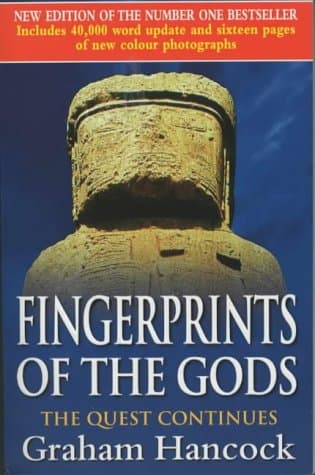
Graham Hancock,Santha Faiia, Fingerprints of the Gods: The Quest Continues
Value For Money
Graham Hancock,Santha Faiia, Fingerprints of the Gods: The Quest Continues
When you purchase through links on our site, we may earn an affiliate commission. Here's how it works.

User Reviews
Value For Money
Graham Hancock ,santha Faiia, Fingerprints Of The
Graham Hancock ,Santha Faiia, Fingerprints of the Gods: The Quest Continues - Graham Hancock's work has always been bordering on the controversial, as far as the main stream academic world is concerned, but that has always been the price paid for pushing the boundaries. Academic frontiers tend to travel at the same rate as the world's tectonic plates and any idea that tries to travel faster than the speed of academia is fair game from powers that be. Whereas in some of Hancock's books such as Underworld or Sign and the Seal, the new theories presented don't require too much of a leap of faith to follow, with this book there are a lot of grand new ideas to try to take on board. That said, at over 600 pages there is a lot of room to throughly explore these ideas, and as such the book moves at a pace that most readers will be able to cope with.
As with a lot of his more recent work, the general theme of the book is an exploration of the roots of civilization. Within the accepted understanding of the rise of culture, technology and organised society there are strands that when unraveled send us off down unexplored or deliberetly ignored avenues. It is these strands, the ones that raise difficult questions, that Hancock weaves together into new and interesting theories.
The book opens by examining the work of Charles Hapgood, an American military science lecturer who had a special interest in old maps. Hapgood's work showed that there are a whole collection of maps that although drawn in the sixteenth centuary are based on much older works. In particular, one appears to show an ice free Antarctica, which, when compared to modern survey evidence, seems to be very accurate. This then begs the question, was the art of cartography being exercised a lot earlier that we assume. If this is the case, then the maps also suggest that this was taking place on a global scale. Hancock's quest in this book then is to try to uncover evidence for a globally connected civilization that has somehow been overlooked.
This is not such a mad theory as it seems. At first it seems unlikely that an advanced culture operating, say, 10-15,000 years ago could go missing, but them you realise how little we actually know from this period. There is almost no writing and very little physical evidence. On top of that, there are a whole series of archaeological oddments that don't fit into the accepted theories, are these the evidence he needs to prove his point? What follows is a massive examination of global misfits and anomalies.
The starting point is Peru and Bolivia and an examination of the creation myths of their earliest cultures. These seem to suggest that at a very early time the region was visited by civilizing dieties, human in form, European-looking, seaborne and knowledgable in science. It is a story that is repeated the length and breath of South America, but where did these people come from? In the earliest time the Olmecs, the oldest known culture in Meso-America seem to have flowered fully formed in a short period of time as if they were gifted knowledge from an as yet invisible culture that preceeded them.
There are many similarities between Meso-America and Egypt and this is examined next. Many would think that there is nothing left to discover in Egypt after two hundred years of exploration. What does prove to be a revelation are the astronomical connections. By examining the precession of the stars, the alignments of ancient sites and the calender systems used, a close relationship with the cultures across the ocean is seen. However, Hancock is not suggesting that it was the ancient Egyptians who sparked the rise of civilization in South America or visa versa, but that they were both aided in their growth by a yet-unseen third party.
The rest of the book is then spent looking for possible places that they may have used as a homeland, and reasons why they are seemingly invisible in terms of evidence to the modern eye. The results are original though may seem a bit of a cop-out to some, as they are difficult to prove one way or the other, you'll have to read the book to see what I mean. Even if you don't agree with the conclusions of the book, there are more that enough original ideas being thrown about to make the journey justify the destination. You may not arrive at the place you thought that you would, but getting there will be a real eye-opener.
Hancock has a masterful way of putting together a wide collection of different theories and presenting them in such a way that the layman can cope with it. He is, after all, aiming for the popular vote not the halls of the academic world, that's not to say that he's not qualified or experienced enough to do that either.
A fairly controversial read, but worth the investment, it's a long book but never boring and in the right circles will be the source of many a debate, and that in itself in my view is enough to justify its existence.
Q&A
There are no questions yet. Be the first to ask a question.